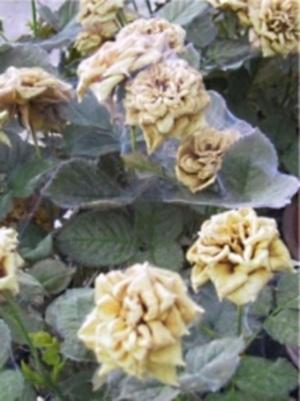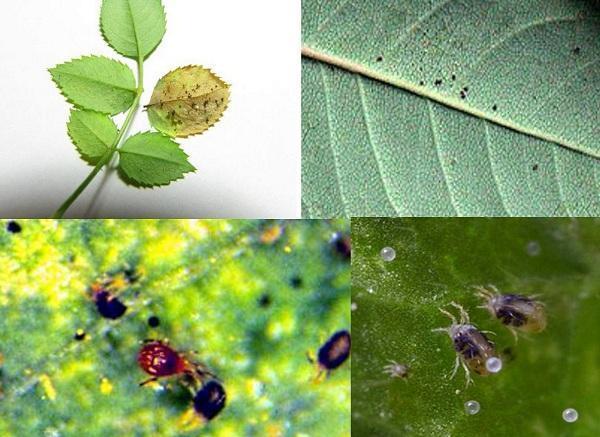Spider mite on a rose - what to do
 Every florist and gardener knows a spider mite by sight. This is the most harmful insect, braiding the plants with cobwebs and sucking out all the juices from it, due to which the leaves and inflorescences gradually dry out and die.
Every florist and gardener knows a spider mite by sight. This is the most harmful insect, braiding the plants with cobwebs and sucking out all the juices from it, due to which the leaves and inflorescences gradually dry out and die.
A feature of this pest is the ability to destroy absolutely any plants - flowers, trees, shrubs.
Roses in this case are no exception, but rather the opposite - the most delicious plant for an insect.
Families of mites that feed on the sap of plant cells include polyphagous individuals that do not pick up food and attack any green plants, as well as specific species that prefer only one type of plant.
Damage inflicted on roses of any type and type by a spider mite leads to foliage falling and a strong susceptibility of the flowering bush to other plant diseases.
Often, not taken measures to combat the tick in time lead to depletion of roses and drying out of seedlings.
Methods for detecting spider mites on a rose
It is not so easy to recognize a harmful insect in the early stages of its reproduction. However, it is possible using a magnifying glass. 
 The first sign of a mite on the leaves of roses is a cobweb.
The first sign of a mite on the leaves of roses is a cobweb.  If you do not take any control measures, then in a few days the rose will look like this, which is extremely harmful to the plant and is not as aesthetically pleasing as possible.
If you do not take any control measures, then in a few days the rose will look like this, which is extremely harmful to the plant and is not as aesthetically pleasing as possible. 
The best breeding ground for the pest is stable hot weather and a large amount of greenery in the area.
If any of the plants in the garden or flowerbed the tick has already settled down, then in a few weeks it can become the most numerous inhabitant, eating a completely different menu of leaves of all green spaces available in the arsenal of the country and garden landscape. The spider mite reproduces with the help of hatched eggs, which are also very difficult to visually notice.
Therefore, having noticed the first signs of a tick living on roses, you should immediately look at all the leaves on the rose bush and remove those on which the existing ticks are sitting. It is recommended to burn all collected infected foliage.
Control measures for spider mites living on rose bushes
- It is possible to cure rose bushes from colonial invasions of spider mites, but it is very difficult in the summer, since there is a lot of greenery on the backyard, which is difficult to process with high quality. But late autumn is the very period when you need to take care of collecting all the fallen leaves from trees and shrubs, in which the spider mite hides for the winter, preventing it from surviving. This is how well-groomed autumn rose beds should look like in order to prevent the possibility of tick breeding in the spring.

- The tick is afraid of cool weather and rainy seasons. Birds, for which the tick is a tasty meal, help to fight harmful insects.
- Many gardeners and florists prefer natural natural methods in the fight against ticks - abundant watering of roses. At the same time, other types of insects do not die, for which the tick is the basis of a nutritious diet in the survival chain.
By treating rose bushes with pesticides, you can kill beneficial insect doctors that eat ticks.
- Flies and spiders are the main enemies of the tick, so you should be careful when examining a bush when a web appears, it may be that this is an ordinary web, woven by a family of spiders. You need to pay attention to the different weaving of the mite web and the spider's web.
- In no case should rose bushes be treated with substances containing phosphates, which increase the specific nitrogen index on rose leaves, which is a very favorable environment for further sustainable reproduction of a harmful insect.
- If there are a large number of ticks on the rose bushes, then it is worth, first, to give preference to spraying the bushes with soapy water, the resulting foam on the foliage does not allow the ticks to scatter in different directions and, due to the impermeability of air, causes their death. Spraying is desirable in cold weather, so that the solution does not dry out instantly. For high-quality spraying of rose bushes, a spray bottle or the so-called garden sprayer is used.
 When processing, it is desirable to pay attention to the underside of the leaves.
When processing, it is desirable to pay attention to the underside of the leaves. - Experienced growers, when processing rose bushes from ticks, prefer Fitoferm.
 Spraying with a solution of this substance is carried out several times at intervals of ten days until the undesirable pest is completely destroyed. No less effective are Aktellik, Neoron, Agraverin, Nissoran.
Spraying with a solution of this substance is carried out several times at intervals of ten days until the undesirable pest is completely destroyed. No less effective are Aktellik, Neoron, Agraverin, Nissoran.
Insecticides do not affect the vital activity of arachnid insects, therefore it is necessary to use agents of the class of acaricides or insectoacaricides, to which the above mentioned drugs belong.
Timely assistance to rose bushes gives such a wonderful result in the end.

Found a quick way to get rid of spider mites on roses. I read many articles, fought for a long time: I tried all the products that are sold, processed them once a week, planted roses in open ground - it helped for a while, but by and large it was unsuccessful, because after a while the nasty tick appeared again. The fight went on with varying success for 2 years. I already decided to throw out the roses, but as a last resort I tried the Mosquitall mite spray (for applying to clothes). Yes, this product is toxic and not intended for plants, but it contains an acaricidal agent. I decided it wouldn't get any worse. I applied it once - I just sprayed it well on the soil in the pot and the plants, including the lower parts of the leaves. At first, the leaves curled up, dried up and fell off, but after 2 weeks they turned green with new leaves, after three weeks buds appeared. Now 1.5 months have passed - there are no ticks, roses have gathered 10-15 buds per bush, the first buds have already blossomed.